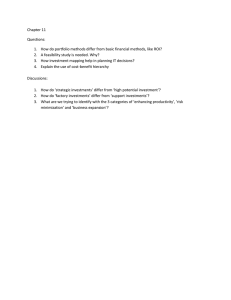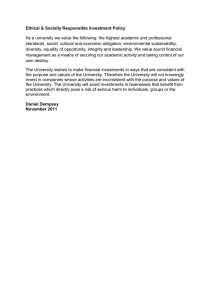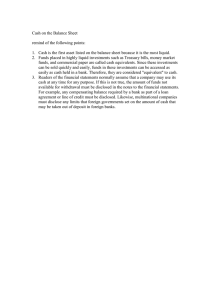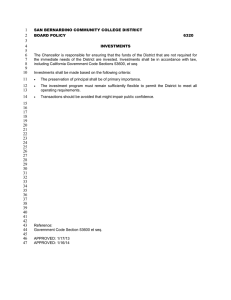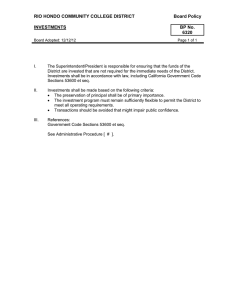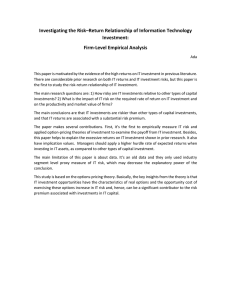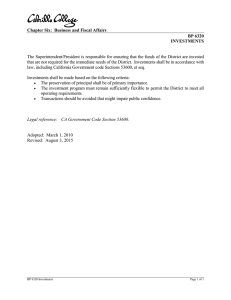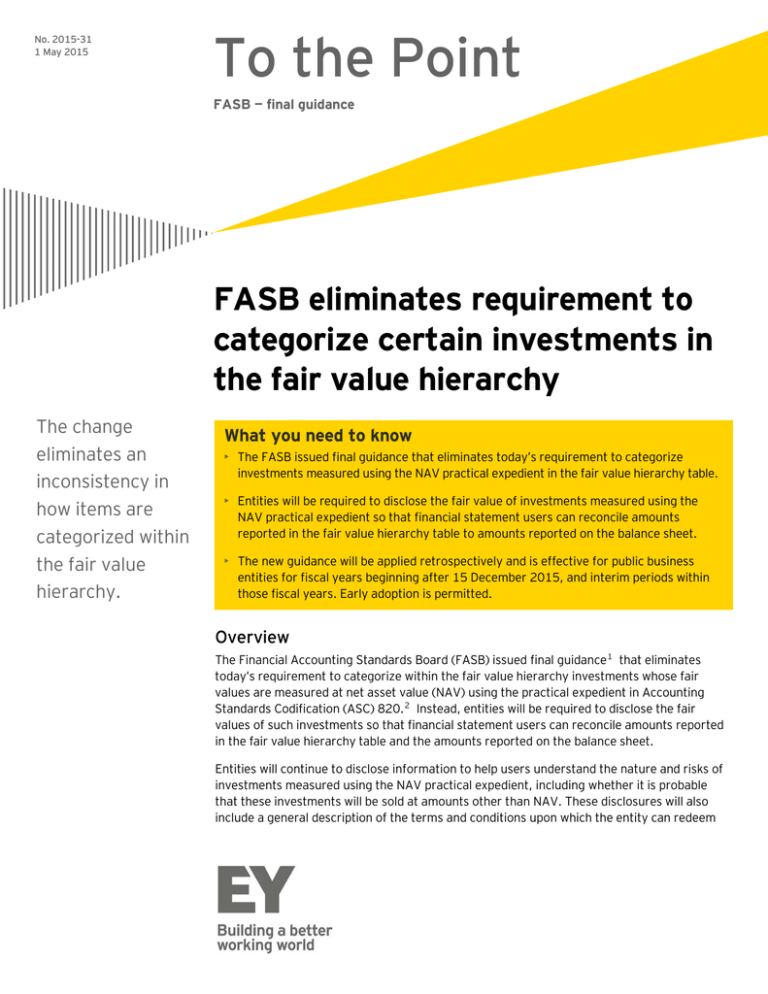
No. 2015-31
1 May 2015
To the Point
FASB — final guidance
FASB eliminates requirement to
categorize certain investments in
the fair value hierarchy
The change
eliminates an
inconsistency in
how items are
categorized within
the fair value
hierarchy.
What you need to know
• The FASB issued final guidance that eliminates today’s requirement to categorize
investments measured using the NAV practical expedient in the fair value hierarchy table.
• Entities will be required to disclose the fair value of investments measured using the
NAV practical expedient so that financial statement users can reconcile amounts
reported in the fair value hierarchy table to amounts reported on the balance sheet.
• The new guidance will be applied retrospectively and is effective for public business
entities for fiscal years beginning after 15 December 2015, and interim periods within
those fiscal years. Early adoption is permitted.
Overview
The Financial Accounting Standards Board (FASB) issued final guidance1 that eliminates
today’s requirement to categorize within the fair value hierarchy investments whose fair
values are measured at net asset value (NAV) using the practical expedient in Accounting
Standards Codification (ASC) 820. 2 Instead, entities will be required to disclose the fair
values of such investments so that financial statement users can reconcile amounts reported
in the fair value hierarchy table and the amounts reported on the balance sheet.
Entities will continue to disclose information to help users understand the nature and risks of
investments measured using the NAV practical expedient, including whether it is probable
that these investments will be sold at amounts other than NAV. These disclosures will also
include a general description of the terms and conditions upon which the entity can redeem
EY AccountingLink | www.ey.com/us/accountinglink
the investments (e.g., quarterly redemption with 60 days’ notice). However, these disclosures
will no longer be required for investments that are eligible for the NAV practical expedient but
are not measured that way.
Background
ASC 820 requires entities to categorize items measured at fair value in one of three levels
in the fair value hierarchy, based on the observability of the inputs used in valuing the
investments. In addition, ASC 820 provides a practical expedient that allows entities to
estimate the fair value of certain investments by using the NAV per share as of their
measurement date.3 Because entities don’t consider valuation inputs when they use the
practical expedient, they can’t use the traditional approach of categorizing these investments
in the fair value hierarchy based on the observability of inputs. Instead, today’s guidance
requires entities that use the practical expedient to categorize these investments in Level 2
or Level 3 of the hierarchy based on whether they can be redeemed in the “near term.”
Excluding certain items from the fair value hierarchy
The new guidance eliminates an inconsistency in how items are categorized in the fair value
hierarchy by excluding investments measured using the NAV practical expedient from
classification within the hierarchy. Because excluding these investments from the tabular fair
value hierarchy disclosure will result in differences between subtotals in the table and specific
line items on the balance sheet, the new guidance requires an entity to disclose the amounts of
the excluded investments so that a financial statement user can reconcile amounts reported in
the table to amounts reported on the balance sheet. It also provides an example of how an
entity might provide this information.
How we see it
All information presented in the fair value hierarchy table will now be based on the relative
observability of inputs used to determine the fair values. The table therefore will better
communicate information about the relative uncertainty of the fair value measurements
underlying the financial statements. This may help alleviate a misconception among some
investors who believe that the fair value hierarchy provides information about the “relative
riskiness” of assets.
Narrowing of certain disclosure requirements
ASC 820 currently requires certain disclosures for items that are “eligible for” the NAV practical
expedient, regardless of whether an entity uses the practical expedient to estimate fair value.4
The new guidance will limit this requirement only to items an entity has measured using the
NAV practical expedient. To help users understand the nature and risks of investments
measured using the NAV practical expedient, and whether it is probable that these investments
will be sold at amounts other than NAV, the following disclosures will continue to be required
for each class of investment that includes items measured using the NAV practical expedient:
•
The fair value measurement and a description of the significant investment strategies of
the investee(s) in the class
•
A general description of the terms and conditions under which the investor may redeem
investments in the class
2 | To the Point FASB eliminates requirement to categorize certain investments in the fair value hierarchy 1 May 2015
EY AccountingLink | www.ey.com/us/accountinglink
•
An estimate of the period of time required for the underlying assets of the investees to be
liquidated for each class of investment that includes investments that can’t be redeemed
with the investees but that will pay the entity distributions when the assets are liquidated
•
The amount of the reporting entity’s unfunded commitments for the investments in the class
•
The circumstances in which an otherwise redeemable investment in the class might not
be redeemable
•
Any other significant restriction on the reporting entity’s ability to sell investments in the
class at the measurement date
How we see it
In practice, entities typically use the NAV practical expedient to estimate the fair value of
eligible investments. As a result, we expect the narrowing of today’s disclosure requirement
to result in little or no change for most entities.
Other considerations
Investments in mutual funds that have readily determinable fair values are not affected by
the Accounting Standards Update (ASU) because they do not qualify for the NAV practical
expedient. As such, an entity will continue to categorize such investments in the fair value
hierarchy. A mutual fund is considered to have a readily determinable fair value if the fair
value per share (or unit) is determined and published and is the basis for current transactions.
Further, the ASU includes conforming amendments to guidance that exempts investment
companies from preparing a statement of cash flows in certain circumstances. 5 Assuming the
other criteria are met, an investment company would not be required to provide a statement
of cash flows if, during the period, substantially all of its investments are carried at fair value
and classified as Level 1 or Level 2 measurements or were measured using the NAV practical
expedient, as long as they are redeemable in the near term at all times.
Effective date and transition
The guidance will be applied retrospectively for public business entities for fiscal years
beginning after 15 December 2015 and interim periods within those years. For entities other
than public business entities, the guidance will be applied for fiscal years beginning after
15 December 2016 and interim periods within those years. Early adoption is permitted.
Endnotes:
1
2
3
4
5
EY | Assurance | Tax | Transactions | Advisory
© 2015 Ernst & Young LLP.
All Rights Reserved.
SCORE No. BB2980
ey.com/us/accountinglink
ASU 2015-07, Fair Value Measurement (Topic 820): Disclosures for Investments in Certain Entities That Calculate
Net Asset Value per Share (or Its Equivalent).
ASC 820, Fair Value Measurement.
ASC 820-10-35-59 through 35-62.
ASC 820-10-50-6A.
ASC 230-10-15-4.
About EY
EY is a global leader in assurance, tax, transaction and advisory services. The insights and quality services we deliver help build trust and confidence in the
capital markets and in economies the world over. We develop outstanding leaders who team to deliver on our promises to all of our stakeholders. In so doing,
we play a critical role in building a better working world for our people, for our clients and for our communities.
EY refers to the global organization, and may refer to one or more, of the member firms of Ernst & Young Global Limited, each of which is a separate legal
entity. Ernst & Young Global Limited, a UK company limited by guarantee, does not provide services to clients. For more information about our organization,
please visit ey.com.
Ernst & Young LLP is a client-serving member firm of Ernst & Young Global Limited operating in the US.
This material has been prepared for general informational purposes only and is not intended to be relied upon as accounting, tax, or other professional advice. Please refer to your advisors for specific advice.
3 | To the Point FASB eliminates requirement to categorize certain investments in the fair value hierarchy 1 May 2015

